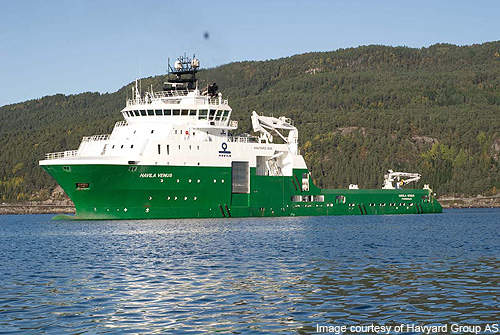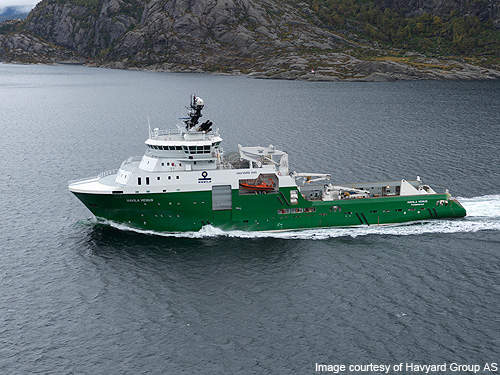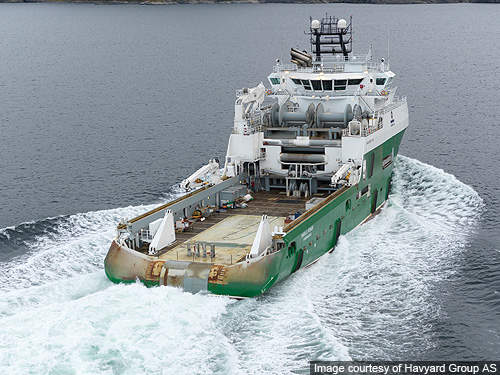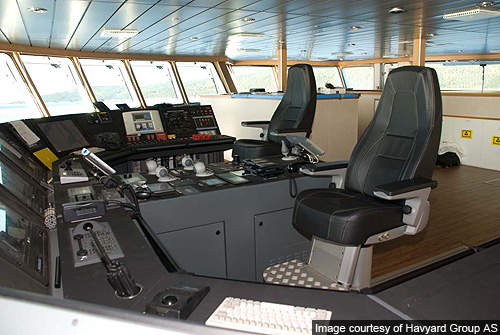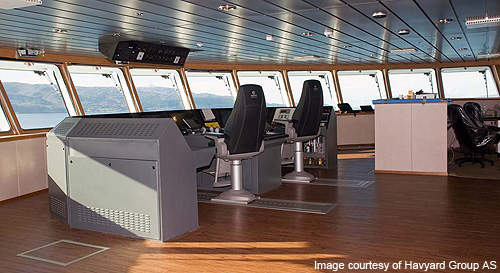Havila Venus is one of the largest anchor-handling tug supply vessels (AHTS) in the world. It was delivered in October 2009 and the naming ceremony was held on 17 October 2009 in Fosnavag, Norway.
The vessel was built at Havyard Group’s shipyard, Havyard Leirvik, and is managed and operated by Havila Shipping. The hull of the vessel was built in Turkey and was supervised by Havyard Ship Services. The electrical engineering for the vessel was provided by Havyard Powertec where as the electrical installations were carried out by Havyard Elektro.
Design and construction
The vessel design is of Havyard 845 type which is developed by Havyard Design. It was designed in accordance with the ship owner’s requirements for economical operation, and at the same time environment, comfort and crew safety were also taken into account.
The vessel has a gross tonnage of 6,455t and dead weight of 3,866t. The maximum displacement of the vessel is 9,687t. Length overall of the vessel is 92m and length between perpendiculars (LPP) has been kept to 79.8m. The moulded breadth, depth to main deck and design draft are 22m, 9m and 6m respectively. The maximum midship draft is 7.53m.
The hull of the vessel, which is made up of steel, has double bottom and double side. The cargo deck, which is built over an area of 750m², is capable of holding 1,500t of cargo.
The vessel’s stern has been optimised to facilitate large propellers and great bollard pull. This arrangement ensures safe operation by providing good stability and buoyancy. The vessel can cruise at a speed of 18kt.
The vessel is capable of accommodating 60 people. They can be accommodated in 16 single cabins, 20 double cabins and one four men cabin.
Propulsion
The vessel is equipped with an advanced hybrid propulsion system designed and developed by Havyard Design and Havila Shipping in collaboration with Scandinavian Electric Systems. This propulsion system reduces fuel consumption of the vessel by 10% to 15% as compared to other systems. It also helps in minimising nitrogen oxide and carbon dioxide emissions.
For propulsion and to power the other equipment, the vessel is equipped with a power station which is capable of generating up to 18,000kW of electricity. The power station combined with the advanced hybrid system generates electricity to power two main propellers, three side thrusters and an azimuth thruster.
Diesel mechanic, diesel electric and hybrid are the three operating modes under which the propulsion system of the vessel works. Hybrid mode is a combination of the first two modes.
The power requirements of an AHTS when moving from A to B are lower compared with the total power resources on board.
In case of diesel electric system, the vessel can run on one large diesel engine that supplies the power required for the propulsion through electric motors. The power requirement varies when the vessel uses Dynamic Positioning System in its operation. In order to optimise safety and fuel consumption, the power supply to the vessel is regulated by its diesel electric system.
In order to generate sufficient power to yield the required bollard pull, the main propellers of the vessel are powered directly in diesel mechanic mode. The bollard pull of the ship can be increased to up to 284t when operating under hybrid mode.
Equipment
The vessel is equipped with powerful, modern anchor-handling winches ensuring safety of the crew. The vessel’s anchor recovery frame (ARF) is used to handle the anchor over the stern, towing pins and shark jaws. The vessel also has two cargo rail cranes with manipulators.
The launch and recovery system (LARS) of the vessel helps it in carrying out the operations of remotely operated vehicles (ROVs) over ship-side. When used in combination with a 250t A-frame on the stern, the LARS can allow the vessel to carry out sub-sea operations at a depth of 3,000m.
In accordance with safety of life at sea regulations, the vessel is equipped with Alusafe 770 Mob boat. It also has a TTS Marine HL9D rescue boat davit, equipped with safe anchor handling package.
Navigation and communication
The vessel is equipped with state-of-the-art navigation and communication equipment. It has two radars, FCR-2837S Furuno S-band ARPA radar and the FAR-2827 Furuno X-band ARPA radar. Other important navigation equipment include a Navipol II magnetic compass, GDS 102 skipper navigational echo sounder, VSS-111 Phonetec sound reception system and Bridge Warch Monitoring System.
The vessel’s communication equipment includes a Furuno NX-700B Navtex receiver, two TRON SART Jotron radar transponders, three Jotron GMDSS approved portable VHFs, one Thrane & Thrane fleet broadband 500 telephone, two Motorola GSM telephones, six Motorola GP 380 EX Portable UHF, and two FM 8800S Furuno VHF/DSC Simplex.

